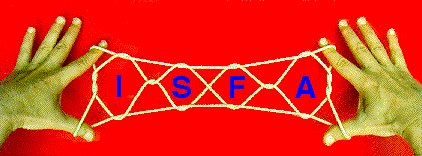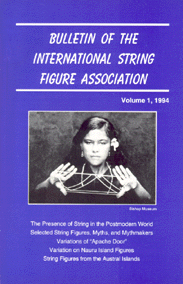Volume 1 (1994): 160 pages - Table des Matières
Edité par - Mark A. Sherman, Pasadena, California
Rédacteurs Associés - Joseph D'Antoni, Queens, New York; Myriam Namolaru, Haifa, Israel;
Belinda Holbrook, Davenport, Iowa; Stephan Claassen, Best, Netherlands.
Comité de Rédaction - Hiroshi Noguchi, Tokyo, Japan; Philip Noble, Inverness, Ecosse
Le Bulletin de l'Association Internationale du Jeu de Ficelle (BISFA) est une publication savante
présentant des documents originaux qui fait progresser notre compréhension et renforce
notre plaisir des jeux de ficelle. BISFA est publié annuellement, en septembre, par ISFA Press
(Pasadena, Californie). BISFA remplace le Bulletin de l'Association des Jeux de Ficelle,
(Toky Nippon Ayatori Kyokai), qui a été publiée en 19 volumes (1978-1993).
Les traductions proposées ne comprennent pas les illustrations et photos du texte original.
J'ai traduit ces textes pour vous donner un aperçu de la qualité et de la richesse de
ces publications.
Commentary
- La Présence de la Ficelle dans le Monde Postmoderne, par Greg Keith, Santa Cruz, Californie, (pages 1-11) - une narration vivante sur la manière dont les jeux de ficelle influencent la vie et les activités d'un écrivain libre et sémillant.
Review Article
- Selected String Figures, Myths, and Mythmakers, by Audrey Collinson Small, Paradise, California, (pages 12-21) - a critical look at how string figures were once intimately associated with tales of ancient gods and mystical sorcerers.
Research Reports
- Variations of "Apache Door," by Udo Englehardt, Berlin, Germany, (pages 22-26) - Instructions for making the Native American string figure commonly known as "Apache Door" were first published by Jayne in 1906. Six recently invented variations are described here.
- Variations on Nauru Island Figures, by Joseph D'Antoni, Queens, New York, (pages 27-68) - Certain manipulation sequences are common to many Nauru Island string figures. These sequences produce a predictable design in a specific part of a figure each time they are applied. Furthermore, these sequences are independent of one another and additive in nature. New figures can be rationally designed by linking these "design units" together in various combinations. One-hundred-thirty-five examples are provided.
- String Figures of the Austral Islands, by J.F.G. Stokes & Mark Sherman, Pasadena, California (pages 69-150) Introduction- Despite over a century of anthropological interest in the Oceanic string figure repertoire, many aspects of the repertoire's evolution remain uncharacterized. The primary obstacle in completing such studies has been the lack of data for several key island groups. This paper partially fills the void by describing thirty-two figures collected in the Austral Islands over seventy years ago by ethnologist J.F.G. Stokes. A multi-disciplinary approach has been taken in analyzing the Austral figures, most of which are from the isolated island of Rapa. A linguistic analysis of Rapan string figure titles suggests that many of the figures date from the prehistoric period, possibly arriving with the first settlers. Long-term familiarity is also indicated by a detailed "methods analysis" which reveals that Rapan construction methods often differ somewhat from those recorded in surrounding territories, an observation which argues against recent introduction. Finally, a comprehensive distribution analysis reveals that the Rapan repertoire is composed of three string figure subgroups: figures known throughout the Pacific (Oceanic core figures), figures known primarily in Polynesia, and figures known only in French Polynesia. Few figures are unique to Rapa. Various aspects of regional history, both ancient and modern, are examined in an effort to understand how the figures recorded by Stokes came to be known in the Australs.
Books in Print (pages 151-158) - by Joseph D'Antoni, Queens, New York.
Letters to the Editor (pages 155-159)
- Tangled History - Philip Noble, Prestwick, Scotland. On the search for evidence of string figures in Great Britain before 1700.
- Opening A, et al. - Joseph Ornstein, New York, New York. On inverse and mirror images of the most common string figure opening.
- Ficelage du Passé au Présent - Sam Cannarozzi Yada, - Burgundy, France. Sur les activités sociales des membres européens d'ISFA
Ajouter un commentaire



